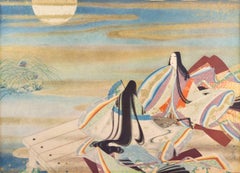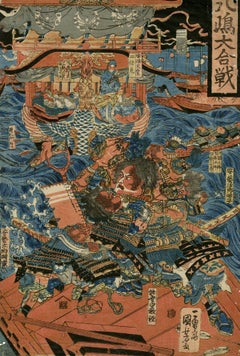Ogyu Tensen Art
to
1
1
1
Overall Height
to
Overall Width
to
1
1
1
1
1
1
1
6,935
3,285
2,514
1,213
1
1
1
1
Artist: Ogyu Tensen
'Musicians Viewing the Full Moon', Large Japanese Color Woodblock Print, Biwa
By Ogyu Tensen
Located in Santa Cruz, CA
Signed, lower right, with artist's chop mark in Hiragana, 'Tensen-e' 天泉絵, for Ogyū Tensen 荻生天泉 (Japanese, 1882-1947)
A large, early-20th-century, hand-colored Japanese woodblock showing elegantly-robed figures seated beside musical instruments in a panoramic landscape and viewing the full moon through golden clouds. An elegant example composed with clear artistic vision and printed with a consummate mastery of a challenging medium.
Nihonga style painter Ogyu Tensen was born in present-day Nihonmatsu City, Fukushima Prefecture. He studied at the Tokyo Fine Arts School, where he was taught by the well-known Kanō school painter Gahō Hashimoto (1835-1908), who was instrumental in the development of nihonga painting. Tensen was selected to participate in the first Bunten exhibition (Ministry of Education Fine Arts Exhibition) in 1907, in which he won an award. He went on to win many other awards at the Bunten exhibitions and the exhibitions of its successor organizations, the Teiten (Imperial Academy of Fine Arts) and Shin Bunten along with exhibitions of the Japan Arts Institute (Nihon Bijutsuin) and the post-war 1946 Nitten (Japan Fine Arts Exhibition). Along with his work in printmaking, the Imperial Court commissioned paintings by him.
Tensen was a member of the Futaba kai artist...
Category
1920s Ogyu Tensen Art
Materials
Fiberboard, Woodcut, Paper
Related Items
The Battle of Dan-no-ura in Yashima, Nagato Province in the First Year .....
By Utagawa Yoshitora
Located in Middletown, NY
The Battle of Dan-no-ura in Yashima, Nagato Province in the First Year of the Bunji Era (1185)
Tokyo c. 1830
Woodblock print (nishiki-e) with ink and hand-coloring in watercolor on handmade mulberry paper, 14 7/16 x 9 15/16 inches (367 x 252 mm), ōban tate-e, the full sheet. In good condition with some handling creases. Colors are fresh and extremely vibrant. The right panel from the triptych by Yoshitora depicting one of Japan's most storied naval battles. An impression of this work may be found in the permanent collection of the Honolulu Museum of Art.
The great naval battle of Dan-no-ura in 1185 was the final climax in a long series of bitter wars between two powerful families in feudal Japan...
Category
Early 19th Century Edo Ogyu Tensen Art
Materials
Handmade Paper, Watercolor, Woodcut
Kiyomizu Temple, Scenes of Famous Places along Tôkaidô Road - Woodblock on Paper
By Utagawa Hiroshige II
Located in Soquel, CA
Kiyomizu Temple, Scenes of Famous Places along Tôkaidô Road - Woodblock on Paper
Full Title:
Kyoto: Kiyomizu Temple (Kyô Kiyomizudera), from the series Scenes of Famous Places along...
Category
1860s Edo Ogyu Tensen Art
Materials
Ink, Rice Paper, Woodcut
"First Horse Day, 1896" - Chiyoda Palace - Japanese Woodblock by Chikanobu Yoshu
By Toyohara Chikanobu
Located in Soquel, CA
"First Horse Day, 1896" - Chiyoda Palace - Japanese Woodblock by Chikanobu Yoshu
Colorful and expressive court scne by Toyohara Chikanobu,"Yoshu" (Japanese, 1838-1912).
This is the r...
Category
1890s Edo Ogyu Tensen Art
Materials
Rice Paper, Ink, Woodcut
H 15 in W 10.5 in D 0.5 in
Japanese Beauty Admiring Kirifuri Waterfall
By Yoshu Chikanobu
Located in Burbank, CA
A beauty turns to admire the Kirifuri Waterfall in Nikko Province. She holds the handle of an umbrella and wears fashionable clothing that is beautifully printed. This series pairs f...
Category
1890s Edo Ogyu Tensen Art
Materials
Mulberry Paper, Handmade Paper, Woodcut
Study of Utagawa Hiroshige's "View of Hara-Juku" 53 Stations of the Tokaido Road
By Utagawa Hiroshige
Located in Soquel, CA
Study of Utagawa Hiroshige's "View of Hara-Juku" 53 Stations of the Tokaido Road
Hand painted study of Utagawa Hiroshige's "View of Hara-Juku", (by unknown artist), from "53 Station...
Category
1920s Edo Ogyu Tensen Art
Materials
Woodcut, Paper, Ink
H 11 in W 14 in D 0.25 in
Beauties on the Beach with view of Mount Fuji
By Yoshu Chikanobu
Located in Burbank, CA
Shichirigahama, Sagami Province. A beauty in the foreground waves to her young companions, who run towards her on the beach. The beauty at left wears a western-style golden ring. We ...
Category
1890s Edo Ogyu Tensen Art
Materials
Mulberry Paper, Handmade Paper, Woodcut
Sumiyoshi: Dengaku dance performed during an Onda ceremony - Woodblock Print
By Utagawa Hiroshige
Located in Soquel, CA
Sumiyoshi: Dengaku dance performed during an Onda ceremony - Woodblock Print
Bright woodblock print by Utagawa Hiroshige (Japanese, 1797-1858). In this scene, two dancers with swords and fans are facing each other, in the center of a courtyard. There are spectators surrounding them, including nobles in black clothing on a balcony.
Presented in a new off-white mat with foamcore backing.
Mat size: 16"H x 20"W
Paper size: 9.63"H x 14.5W"
Utagawa Hiroshige (1797-1858, sometimes called Ando Hiroshige) was the second of the two great masters of the Japanese landscape woodblock print...
Category
1830s Edo Ogyu Tensen Art
Materials
Ink, Rice Paper, Woodcut
3 Panel Hand Colored Japanese Woodcut Print Lithograph
By Keisai Eisen
Located in Soquel, CA
3 Panel Hand Colored Japanese Woodcut Print Lithograph
Three panel hand colored woodcut lithograph from Nanso Satomi hakkenden, Tale of the Eight Dogs...
Category
Early 19th Century Edo Ogyu Tensen Art
Materials
Paper, Ink, Woodcut
Amsterdam - Woodcut Print by Frans Masereel - 1933
By Frans Masereel
Located in Roma, IT
Amsterdam is an artwork realized by Frans Masereel, 1933.
Woodcut print representing Amsterdam.
75 x 55 with frame; 17h x 12 cm each work.
Good conditions.
Category
Early 20th Century Modern Ogyu Tensen Art
Materials
Woodcut, Paper
No Reserve
H 29.53 in W 21.66 in D 0.4 in
"Various Himochi" Wagashi Festival Japanese Woodblock Print by Utagawa Toyokuni
Located in Soquel, CA
"Various Himochi" Wagashi Festival Japanese Woodblock Print by Utagawa Toyokuni
Rare oversized early 19th century 5-tiered woodblock by Utagawa Ichiyosai Toyokuni, (Japan, 1769-1825), a Japanese lord and wife oversee a sekku festival of food, music, and dolls or toys. '"oshi" is the first day of “Mi (Snake)” in the third month of the lunar calendar. This day, known in modern Japan as the Girls' Festival, originated in China as a form of purification ceremony in which water and drinking peach blossom wine were used to drive away evil. Many kinds of hishi-mochi appear in this picture of hina ningyo (dolls associated with Hinamatsuri, or the Girl’s Day) from Omochae.
The custom of eating special dishes at events throughout the year and at milestones in people's lives has existed since ancient times. This paragraph specifically focuses on the annual event called sekku, and life events that involve eating sweets. Joshi is the first day of “Mi (Snake)” in the third month of the lunar calendar. This day, known in modern Japan as the Girls' Festival, originated in China as a form of purification ceremony in which water and drinking peach blossom wine were used to drive away evil. According to the Keiso saijiki, in ancient China, on the third day of the third lunar month, people ate “ryuzetsuhan,” which is the juice of gogyo (Jersey cudweed) mixed with rice flour and nectar. In Japan, there is a record in the Heian period history book Nihon Montoku tenno jitsuroku [839-5] that it was an annual event to make kusamochi using gogyo on the third day of the third month of the lunar calendar, which may have been influenced by Chinese customs.
The tradition of eating kusamochi on the third day of the third month of the lunar calendar continued after that. By the Edo period, however, hishimochi had come to be used as a sweet to serve on the third day of the third month. A picture of a hishimochi is included in the Morisada manko , which we mentioned in Part 1. According to it, hishimochi in the Edo period were often three layers of green-white-green instead of the now common red-white-green. However, it is possible to see from our collection that not all hishimochi were made in this way. Omochae published in 1857, is a good example. Omochae is a type of ukiyoe print...
Category
1820s Edo Ogyu Tensen Art
Materials
Ink, Rice Paper, Woodcut
H 26.75 in W 21.75 in D 0.25 in
Elia Shiwoohamba ( Namibia, 1981 ) Harvesting Time Lino Cut African School 2006
By Elia Shiwoohama
Located in Meinisberg, CH
Elia Shiwoohamba
(* 1981 , Windhoek, Namibia )
Harvesting Time
• African School
• Linoleum cut
• Sheet ca. 34.5 x 43 cm (Image is smaller)
• Bottom left numbered 8/50 and titled
• ...
Category
Early 2000s Expressionist Ogyu Tensen Art
Materials
Paper, Linocut, Woodcut
Elia ShiwoohamaElia Shiwoohamba ( Namibia, 1981 ) Harvesting Time Lino Cut African School 2006, 2006
Free Shipping
H 13.59 in W 16.93 in
Modern American Industrial Landscape
Located in Buffalo, NY
An original woodblock print dated 1965, titled "Our Town" but signed illegibly.
Category
1960s American Modern Ogyu Tensen Art
Materials
Woodcut, Paper
Ogyu Tensen art for sale on 1stDibs.
Find a wide variety of authentic Ogyu Tensen art available for sale on 1stDibs. You can also browse by medium to find art by Ogyu Tensen in board, fiberboard, gold leaf and more. Not every interior allows for large Ogyu Tensen art, so small editions measuring 33 inches across are available. Ogyu Tensen art prices can differ depending upon medium, time period and other attributes. On 1stDibs, the price for these items starts at $5,500 and tops out at $5,500, while the average work can sell for $5,500.


